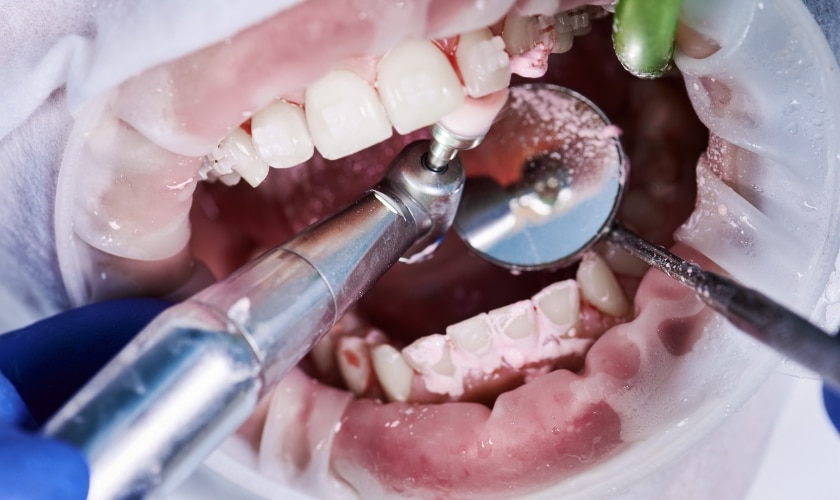Certain treatments may be helpful if you want to whiten your yellow teeth, but use caution when using at-home whitening solutions to prevent chipping and erosion of your enamel, which increases your risk of cavities and tooth sensitivity.
Your teeth’s color may gradually change and become less noticeable. Some yellow hue can be unavoidable.
Particularly as you get older, teeth may appear more yellow or darken. Yellowing dentin beneath the outer enamel wears away and shows more clearly. Beneath the outer layer of enamel lies the second layer of calcified tissue, known as dentin.
Continue reading to find out how to safely whiten your teeth and your options.
Remedies for yellow teeth
These are seven natural remedies that can be used to whiten teeth.
It can be most effective to select a few treatments and switch them up every week. Although there isn’t any scientific evidence to back up some of the recommendations below, anecdotal evidence suggests they work.
To find a solution that works for you, try different things.
1. Brushing your teeth
Your primary course of action should involve brushing your teeth more frequently and with proper technique. This is particularly crucial after consuming foods and beverages known to cause yellowing of teeth.
However, exercise caution when brushing immediately after consuming acidic substances. Brushing too soon can exacerbate enamel erosion by facilitating the removal of enamel due to the presence of acids.
Ensure you brush your teeth at least twice daily for a duration of 2 minutes each time. Pay attention to reaching all areas, including the crevices, and employ a gentle circular motion to safeguard your gums. Cover all surfaces of teeth, including inner, outer, and chewing surfaces.
Using a whitening toothpaste has been scientifically proven to enhance the brightness of your smile. These toothpastes typically contain mild abrasives that effectively eliminate surface stains while being gentle enough to avoid harm.
Opting for an electric toothbrush may also prove more effective in removing surface stains.
2. Baking soda and hydrogen peroxide
A paste composed of baking soda and hydrogen peroxide is purported to effectively eliminate plaque buildup and bacteria, thereby addressing stains.
Mix 1 tablespoon of baking soda with 2 tablespoons of hydrogen peroxide to create the paste. After brushing with this paste, thoroughly rinse your mouth with water. You can also utilize the same ratio of ingredients to concoct a mouthwash. Additionally, you can attempt a mixture of baking soda with water.
You can conveniently purchase both baking soda and hydrogen peroxide online.
Research has shown that individuals who utilized a toothpaste containing baking soda and peroxide experienced a reduction in tooth stains and an enhancement in tooth whiteness. Significant improvements were observed after a duration of 6 weeks.
Studies regarding toothpaste containing baking soda have also affirmed their efficacy and safety in removing tooth stains and whitening teeth. Using these toothpastes daily is not a problem.
3. Coconut oil pulling
Coconut oil pulling contributes to teeth whitening by effectively removing plaque and bacteria from the mouth. When choosing coconut oil, opt for a high-quality, organic option devoid of harmful additives, readily available for purchase online.
To perform oil pulling, swish 1 to 2 teaspoons of liquid coconut oil in your mouth for 10 to 30 minutes, ensuring the oil does not reach the back of your throat. Refrain from swallowing the oil as it may contain toxins and bacteria from the mouth. Dispose of the oil in the toilet or a wastepaper basket to prevent drain blockage, then rinse your mouth with water and drink a full glass of water before brushing your teeth.
While there isn’t definitive research confirming the teeth-whitening effects of oil pulling, a study has shown that oil pulling with sesame oil and sunflower oil reduced gingivitis induced by plaque. Since plaque buildup can cause teeth discoloration, oil pulling may indirectly contribute to teeth whitening.
4. Apple cider vinegar
Apple cider vinegar can be utilized in small quantities for teeth whitening purposes.
To create a mouthwash, mix 2 teaspoons of apple cider vinegar with 6 ounces of water. Swish the solution in your mouth for 30 seconds, then rinse with water and proceed to brush your teeth.
Ensure to purchase apple cider vinegar from a reliable source.
Research has demonstrated that apple cider vinegar possesses bleaching properties, as evidenced by studies conducted on cow teeth.
However, it’s important to note that apple cider vinegar has the potential to harm the hardness and surface structure of teeth. Therefore, it should be used cautiously and for short durations only. Further human studies are necessary to delve deeper into these findings.
5. Lemon, orange, or banana peels
There is a belief among some individuals that rubbing lemon, orange, or banana peels on teeth can result in whitening, attributed to the presence of d-limonene and/or citric acid in citrus fruit peels.
To attempt this method, gently rub the fruit peels on your teeth for approximately 2 minutes. Afterwards, thoroughly rinse your mouth and brush your teeth.
However, scientific evidence supporting the effectiveness of fruit peels for teeth whitening is limited.
A study examined the impact of a toothpaste containing 5 percent d-limonene on removing teeth stains from smoking and tea. Individuals who used this toothpaste, along with a whitening formula, twice daily for 4 weeks experienced significant reduction in smoking stains, though it did not eliminate long-standing smoking or tea stains.
Further research is necessary to determine the efficacy of d-limonene independently. Another study reported that do-it-yourself whitening with strawberries or citric acid was ineffective.
In a separate study, citric acid extracts from four different types of orange peel were evaluated for their potential as teeth whiteners. Results showed varying abilities among the extracts, with tangerine peel extract exhibiting the most promising outcomes.
It’s important to exercise caution with this method due to the acidic nature of fruit, which can potentially erode tooth enamel. If you experience increased tooth sensitivity, discontinue use of this method.
6. Activated charcoal
Activated charcoal possesses high absorbent nature that supposedly effectively removes stains from teeth by eliminating pigments and stains. Moreover, it is thought to eradicate bacteria and toxins from the mouth. Toothpastes containing activated charcoal are marketed for teeth whitening purposes, and activated charcoal for teeth whitening is available for purchase online. Open a capsule of activated charcoal, apply the contents onto your toothbrush, and gently brush your teeth using small circular motions for 2 minutes. Be cautious around the gum area as it can be abrasive. Spit out the charcoal without brushing too aggressively. If you have sensitive teeth or wish to minimize abrasiveness, apply the charcoal directly to your teeth and leave it on for 2 minutes.
Alternatively, you can mix activated charcoal with a small amount of water to create a mouthwash. Swish this solution in your mouth for 2 minutes and then spit it out. Rinse your mouth thoroughly with water afterward.
Scientists need further scientific evidence to fully understand the effectiveness of activated charcoal for teeth whitening. One study reported that charcoal toothpaste can whiten teeth within 4 weeks of use, but it was less effective than other whitening toothpastes.
Research has indicated that activated charcoal can be abrasive on teeth and tooth-colored restorations, potentially leading to loss of tooth structure. This abrasiveness may contribute to teeth appearing more yellow over time.
Given the lack of evidence regarding its effectiveness and safety, caution should be exercised when using charcoal and charcoal-based dental products.
7. Eating fruits and vegetables with a higher water content
It is often suggested that consuming raw fruits and vegetables with high water content can contribute to maintaining healthy teeth. The water content in these foods is believed to cleanse the teeth and gums by removing plaque and bacteria, thereby preventing yellowing.
Chewing on crunchy fruits and vegetables, particularly after meals, may stimulate saliva production, aiding in the removal of food particles stuck in teeth and neutralizing harmful acids.
While a diet rich in fruits and vegetables is undoubtedly beneficial for dental and overall health, there is limited scientific evidence supporting these specific claims. However, incorporating these nutritious foods into your daily diet is unlikely to cause harm.
A review highlighted that vitamin C deficiency could exacerbate periodontitis, a condition affecting the gums. Although the study did not investigate the whitening effects of vitamin C on teeth, it suggested a link between high plasma vitamin C levels and dental health, indicating that elevated vitamin C levels may reduce plaque accumulation responsible for tooth discoloration.
Additionally, a study revealed that a toothpaste containing papain and bromelain extracts demonstrated significant stain removal. Papain is an enzyme found in papaya, while bromelain is present in pineapple.
Further research is necessary to delve deeper into these findings and ascertain the effectiveness of these natural components in promoting dental health and teeth whitening.
What causes yellow teeth?
Teeth can appear yellow for a variety of reasons, including yellowing of the teeth. Among these are:
- Consumption of Certain Foods or Drinks: Foods and beverages like blueberries, red wine, coffee, and tea contain pigments that can stain teeth over time.
- High Sugar and Simple Carbohydrate Diet: A diet rich in sugars and simple carbohydrates can promote bacterial growth and plaque formation, contributing to yellowing of teeth.
- Smoking or Chewing Tobacco: Tobacco products, whether smoked or chewed, contain tar and nicotine that can stain teeth, resulting in a yellowish appearance.
- Side Effects of Medications and Mouthwashes: Some medications and mouthwashes may have side effects that include teeth discoloration.
- Age: As individuals age, the outer enamel layer of teeth can wear away, revealing the yellowish dentin underneath, leading to yellow teeth.
- Genetics: Genetic factors can influence the natural color and thickness of enamel, affecting the appearance of teeth.
- Mouth Trauma: Trauma or injury to the mouth can cause teeth to darken or develop a yellowish hue.
- Excessive Fluoride Consumption: Overexposure to fluoride, whether through drinking water, supplements, or dental products, can lead to fluorosis and result in yellow or brown stains on teeth.
- Poor Dental Care and Oral Hygiene: Inadequate brushing, flossing, and dental check-ups can allow plaque and tartar buildup, leading to yellowing of teeth over time.
- Chronic Dry Mouth or Lack of Saliva: Reduced saliva production or chronic dry mouth can result in decreased natural cleansing and remineralization of teeth, contributing to discoloration.
You can try a lot of at-home teeth-whitening methods.
Take care, though, as you can harm your gums or enamel, which could result in cavities and discomfort. The best strategy to whiten your teeth is to keep up with routine dental check ups, remove stains before they occur, and practice proper oral hygiene.
If you’ve tried these methods without success, visit our dental office, where our experienced professionals can help you determine if another treatment method may be a better option.


